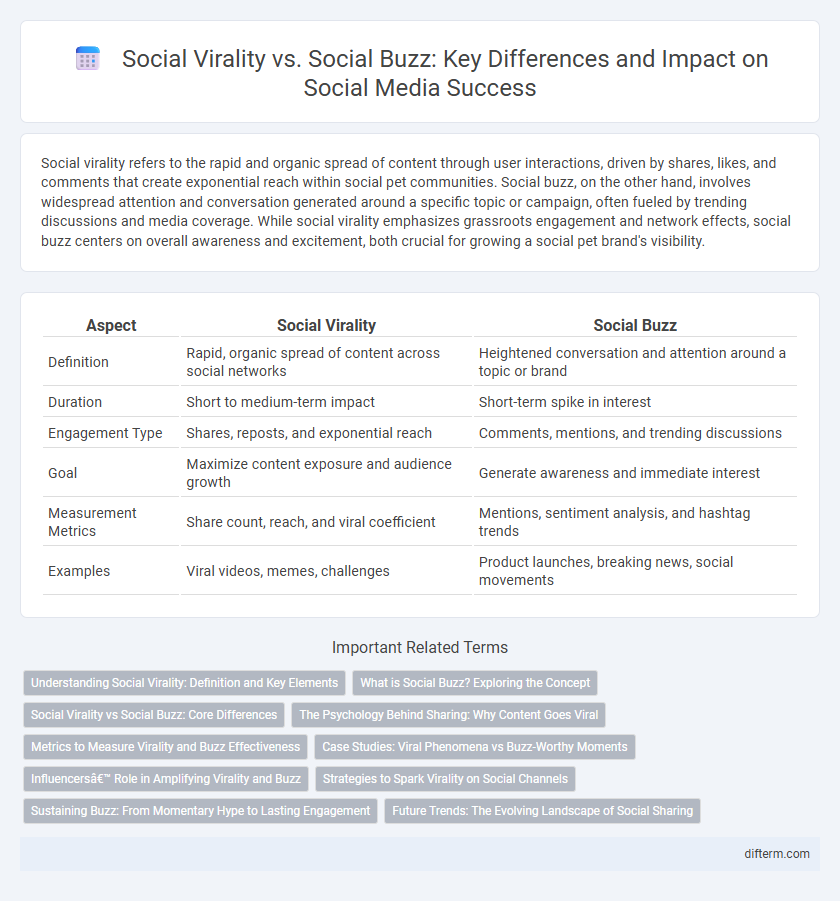Social virality refers to the rapid and organic spread of content through user interactions, driven by shares, likes, and comments that create exponential reach within social pet communities. Social buzz, on the other hand, involves widespread attention and conversation generated around a specific topic or campaign, often fueled by trending discussions and media coverage. While social virality emphasizes grassroots engagement and network effects, social buzz centers on overall awareness and excitement, both crucial for growing a social pet brand's visibility.
Table of Comparison
| Aspect | Social Virality | Social Buzz |
|---|---|---|
| Definition | Rapid, organic spread of content across social networks | Heightened conversation and attention around a topic or brand |
| Duration | Short to medium-term impact | Short-term spike in interest |
| Engagement Type | Shares, reposts, and exponential reach | Comments, mentions, and trending discussions |
| Goal | Maximize content exposure and audience growth | Generate awareness and immediate interest |
| Measurement Metrics | Share count, reach, and viral coefficient | Mentions, sentiment analysis, and hashtag trends |
| Examples | Viral videos, memes, challenges | Product launches, breaking news, social movements |
Understanding Social Virality: Definition and Key Elements
Social virality refers to the rapid and widespread sharing of content across online platforms, driven by high engagement and emotional resonance. Key elements include shareability, relevance, and the network effect, where each share exponentially increases content visibility. Understanding these factors helps marketers design campaigns that trigger organic amplification and maximize audience reach.
What is Social Buzz? Exploring the Concept
Social buzz refers to the volume of online conversations and interactions about a brand, product, or event within social media platforms and communities. It emphasizes qualitative engagement, including sentiments, opinions, and user-generated content that contribute to brand awareness and reputation. Tracking social buzz helps marketers identify trends, measure audience enthusiasm, and tailor communication strategies for effective social media marketing campaigns.
Social Virality vs Social Buzz: Core Differences
Social virality refers to the rapid and exponential spread of content through shares and interactions, often driven by algorithms and network effects. Social buzz, on the other hand, encompasses widespread public attention and conversations around a topic or brand, typically fueled by engagement such as comments, mentions, and media coverage. The core difference lies in virality's emphasis on organic replication and velocity, whereas buzz highlights sustained interest and diverse audience participation.
The Psychology Behind Sharing: Why Content Goes Viral
The psychology behind sharing reveals that content goes viral when it triggers strong emotional responses such as awe, surprise, or amusement, compelling users to share with their networks. Social virality depends on a combination of social currency, emotional arousal, and practical value, driving rapid and widespread dissemination beyond initial audiences. In contrast, social buzz often involves short-term attention spikes without sustained sharing momentum or deep emotional engagement.
Metrics to Measure Virality and Buzz Effectiveness
Social virality is measured by metrics such as share rate, viral coefficient, and reach growth, which indicate how quickly and widely content spreads across networks. Social buzz effectiveness is evaluated through sentiment analysis, engagement rate, and brand mentions to assess audience reaction and conversation intensity. Monitoring these metrics helps marketers optimize campaigns for greater impact and sustained social presence.
Case Studies: Viral Phenomena vs Buzz-Worthy Moments
Social virality refers to content that spreads rapidly and exponentially across networks, often exemplified by case studies like the ALS Ice Bucket Challenge, which garnered global participation and media coverage in 2014. Social buzz involves sustained conversations and engagement around specific moments or brands, demonstrated by campaigns such as Oreo's Super Bowl blackout tweet, which generated widespread real-time interaction without necessarily going viral. Analyzing these case studies reveals that viral phenomena rely on shareability and emotional impact, while buzz-worthy moments depend on timing and relevance to consumer sentiment.
Influencers’ Role in Amplifying Virality and Buzz
Influencers play a crucial role in amplifying social virality and buzz by leveraging their large, engaged followings to rapidly spread content across platforms like Instagram, TikTok, and Twitter. Their authentic endorsements trigger widespread sharing and conversation, significantly increasing the reach and impact of marketing campaigns and viral content. Brands harness influencers to create a multiplier effect, turning localized interest into global awareness efficiently.
Strategies to Spark Virality on Social Channels
Strategies to spark social virality focus on creating highly engaging and shareable content that resonates emotionally with target audiences. Leveraging influencer partnerships, timely trends, and interactive formats such as polls or challenges significantly boosts content reach and user participation. Optimizing posts for platform algorithms through consistent posting schedules and audience analytics increases the likelihood of viral amplification on social channels.
Sustaining Buzz: From Momentary Hype to Lasting Engagement
Sustaining social buzz requires moving beyond momentary hype to foster meaningful, ongoing engagement that resonates with the target audience. Brands leveraging interactive content, timely responses, and community-building strategies can transform fleeting viral moments into lasting social presence. Effective use of social listening tools and consistent value delivery ensures the maintenance of audience interest and drives deeper connections over time.
Future Trends: The Evolving Landscape of Social Sharing
Social virality drives exponential sharing through highly engaging content that triggers rapid user participation across networks, while social buzz emphasizes widespread discussion and brand perception over time. Future trends indicate an increased integration of AI-driven analytics to predict viral potential and monitor real-time buzz, enhancing strategic social media campaigns. Emerging technologies like augmented reality and interactive content will further transform the dynamics of social sharing, blurring the lines between virality and sustained buzz.
social virality vs social buzz Infographic

 difterm.com
difterm.com